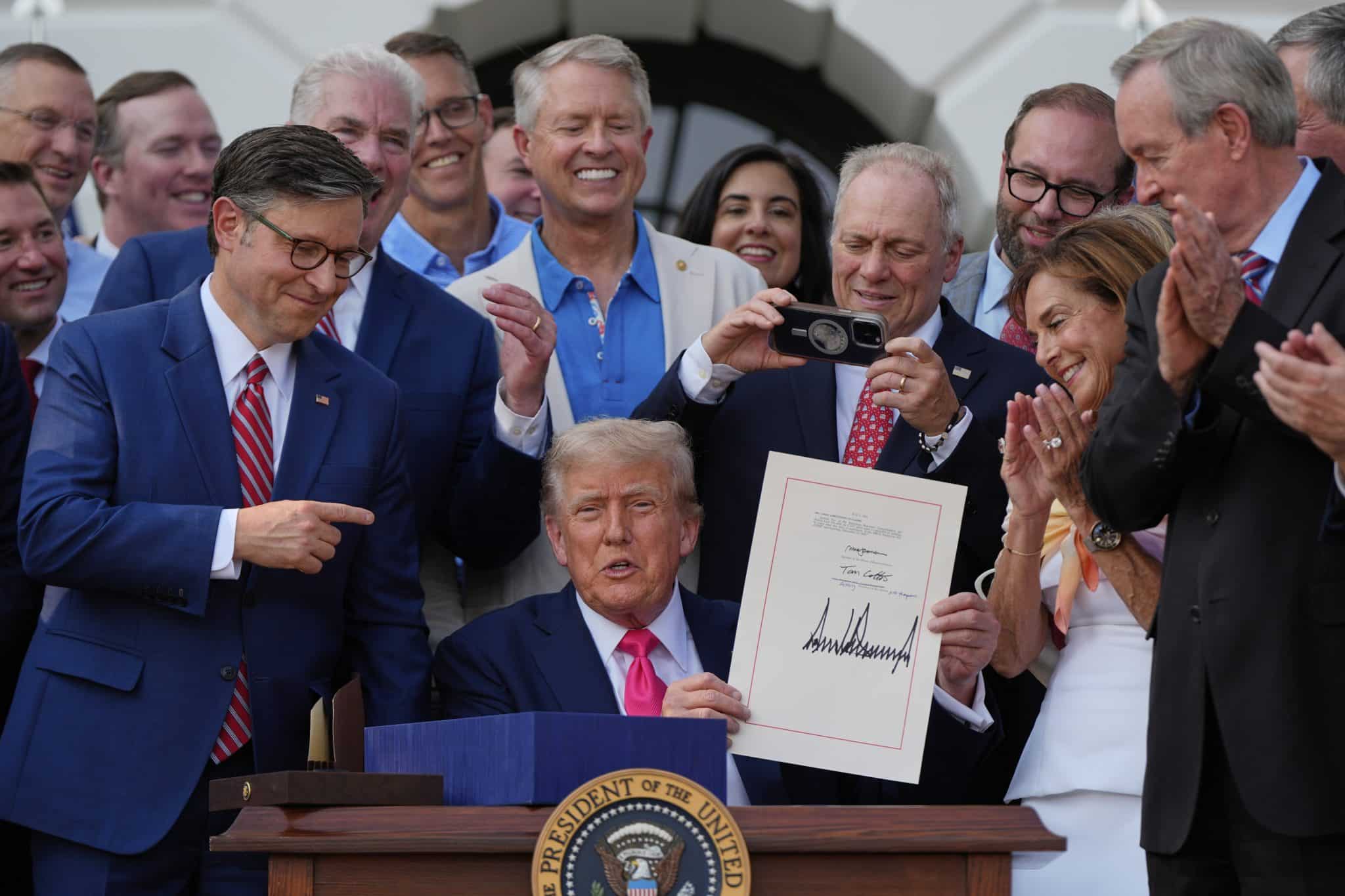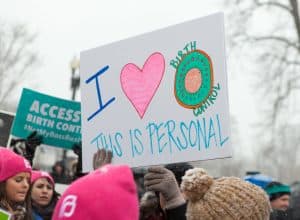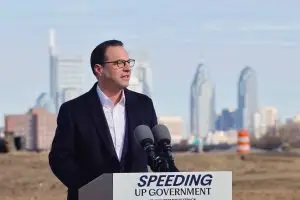Written by Jonathan Shorman and Kevin Hardy, Stateline
PITTSBURG, Kan. — Amid a summer swelter last week, more than 80 people crowded into a trendy gastropub in downtown Pittsburg, Kansas, for cold drinks and hot talk.
The subject? Democrats.
After disappointing results in November, Kansas state House Democrats are touring the Republican-leaning state, trying to improve relationships and set the stage for a comeback. Pittsburg, a college town of 20,500 in the southeastern corner of the state, elected a Democratic state representative as recently as 2018 before choosing a Republican in the past three elections.
“Your guys’s messaging sucks,” local resident Justin Mcelwain told a panel of state Democratic lawmakers during the Q&A portion of the town hall-style event last Thursday, adding that when it comes to getting their points across, Democrats “are not even in the same sphere as the right wing.”
Earlier, Mcelwain had raised his hand along with a handful of others to indicate he had never before attended a political event.
During a brief interview, he described his political views as “so far to the left that guns are cool again.” What Democrats need to do, he said, is repeatedly emphasize the effects of President Donald Trump’s and Republicans’ policies.
“They need to drive it home and hold on to that forever — that your life, over the next five, 10 years or whatever, all the decline in your quality of life is a direct result of the Republican Party,” Mcelwain said.
Some state-level Democrats believe Trump’s One Big Beautiful Bill Act provides a perfect opening.
Trump signed the massive tax cuts and spending legislation into law on Independence Day. The sweeping measure cuts more than $1 trillion from Medicaid, the safety net insurance program funded jointly by the federal government and states. It slashes spending on food assistance and green energy programs and cuts taxes in a way that overwhelmingly benefits the wealthiest earners.
In Kansas and a majority of states, Republicans dominate the legislature, with many increasingly tying themselves to the Make America Great Again movement. As Democrats search for a path back to power, both at the federal and state levels, they are seizing on Trump’s signature legislation six months into his second term as a major rallying cry.
“Let’s not even get started about the one big beautiful awful bill,” Kansas state House Minority Leader Brandon Woodard told the Pittsburg crowd.
A few audience members groaned in agreement.
Trump’s sweeping law is an opportunity, Kansas Democratic Gov. Laura Kelly, who chairs the Democratic Governors Association, said in an interview with Stateline. Portions of it “are so obviously cruel and detrimental to so many people,” she said. Reductions to Medicaid and food assistance, for example, will cut across party lines.
Kelly said Republicans already appear worried about the political consequences: She pointed to efforts by U.S. Sen. Josh Hawley, a Missouri Republican, to repeal some of the federal cuts to the safety net health program.
“I do think that they’re very concerned, as they should be,” Kelly said. “And I hope that the public stays engaged, stays informed, continues to protest as they have been, and that those of us in positions to educate and inform take that role very seriously.”
‘Not a bumper sticker bill’
The law’s enactment comes as Democrats have been searching for a compelling message. They’re trying to connect with disaffected voters after Trump and Republicans attacked the party last year as elitist and out of touch, and they’re highlighting Trump’s actions since his inauguration.
But amid a daily barrage of Trump developments, the party has been pulled in a multitude of directions — spotlighting everything from violent immigration raids to Trump’s connections to convicted child sex offender Jeffrey Epstein.
Earlier this month, the Democratic Legislative Campaign Committee, which works to elect Democrats at the state level, launched ads in several states with upcoming competitive legislative races slamming Republicans “for selling us out” with Trump’s tax and spending law.
The group is focusing heavily on New Jersey and Virginia, the two states with legislative and gubernatorial races in the fall. In 2026, it will target swing states including Michigan and Wisconsin, but also divided states, such as Kansas, North Carolina and Pennsylvania, that have Democratic governors but Republican control of one or both legislative chambers.
Nevada Assembly Speaker Steve Yeager, a board member of the Democratic Legislative Campaign Committee, said Republicans have failed to live up to the rhetoric of the 2024 race that focused largely on lowering costs, presenting a “big opportunity” for his party.
In his state, Republican Gov. Joe Lombardo is expected to face one of the nation’s most competitive gubernatorial races next year.
Yeager said Nevada Democrats will tell voters about the “complicity” of Republicans at the state level — and share a positive vision of Democratic priorities.
“I think Democrats in Nevada and nationwide are a little more clear-eyed in terms of what our objective is and should be, and that’s just to help people with the day-to-day issues that they face,” he said.
State Democrats may also look to a GOP strategy from 15 years ago.
Chris Cooper, a professor of political science and public affairs at Western Carolina University, wondered whether Democrats would employ Trump’s “big, beautiful” law against Republicans the way the GOP used President Barack Obama’s signature health care law against his allies.
READ: 6 Ways Trump’s Budget Will Hurt Rural Pennsylvania
“Is this going to become the Republican version of Obamacare?” Cooper asked. Despite proving popular over time, the passage of the Affordable Care Act was initially a political albatross for Democrats, who lost hundreds of seats in statehouses in 2010, Cooper said.
But at hundreds of pages long, Trump’s federal legislation will require lots of education for voters to fully appreciate the implications to taxes, social services and immigration. And many of the deepest cuts won’t be felt for months or years, with Republicans setting up the cuts to go into effect after the midterm elections.
“It’s not a bumper sticker bill,” Cooper said.
“The Democratic strategy can’t just be, ‘Remember what happened,’” he said. “First they have to teach people what happened, and then they have to work to assign blame, and then they have to work to mobilize that blame to their benefit.”
In Pennsylvania, officials expect more than 300,000 residents to lose health coverage through Medicaid cuts and over 140,000 to lose food assistance. Pennsylvania Democratic state Sen. Vincent Hughes said Republicans will be held accountable for that devastation in next year’s state races.
“The very loud silence coming from Republican elected officials, MAGA elected officials, Trump-loving elected officials all across the country, that will be spoken about, that will be talked about, because their silence screamed volumes,” Hughes said. “They chose to look the other way, knowing the kind of damage this would do.”
For their part, national Republicans have sought to frame the law as a major win because of its deep tax cuts and huge influx of spending on immigration enforcement. At the state level, the messaging has so far been more mixed. In May, 20 of the nation’s 27 GOP governors signed a letter in support of the bill.
The Republican Legislative Campaign Committee, the party’s state committee, did not respond to Stateline’s requests for comment.
Michigan state Sen. Aric Nesbitt, former chair of the committee, said that Democrats “will feel the consequences next year” of opposing Trump’s bill. The minority leader of Michigan’s state Senate, Nesbitt is running to be the GOP’s nominee for governor.
“Democrats walked the political plank by voting for a $2,000 tax increase on working families, for allowing illegal immigrants to continue collecting Medicaid, against eliminating taxes on tips, overtime & Social security benefits, for [former President Joe] Biden’s war on American energy & against enforcing our immigration laws,” he wrote in a statement to Stateline.
Democrats ‘fight back’
This summer, Kansas House Democrats have embarked on a “Fight Back” tour across the state, visiting communities where the party has struggled in recent years.
“We’re going to places that unless there’s someone representing them as a Democrat, we’re being defined by cable news as to what a Democrat is,” Woodard, the Kansas House minority leader, told Stateline.
In Pittsburg, some Democrats said they are unsure whether the federal tax and spending law will help shake loose Republicans’ grip locally.
Janice Arthur, a lifelong Democrat who retired after working in the customer service industry, refused to say Trump’s name as she spoke about the legislation, declaring there’s “nothing about the current occupant of the White House that I agree with or I appreciate.”
When asked whether the law would cause her Republican friends and neighbors to vote for Democrats, she voiced uncertainty. “I don’t know,” she said.
Pittsburg was historically a Democratic stronghold in Republican-leaning Kansas. The party lost substantial ground locally over the past two decades, until the last Democratic state representative failed to win reelection in 2020. Last year, the city’s Democratic candidate for the state House received just 40% of the vote.
But these are the kinds of races Kansas Democrats will have to win if they want to break the Republican supermajority in the state legislature and, one day, take control of a chamber — something that hasn’t happened since the 1990s. Democrats need to flip five seats in 2026 to end the Republicans’ veto-proof majority in the House.
Emily Walters, who chairs the Crawford County Democratic Party, which includes Pittsburg, said many voters locally cast ballots for the first time last year, enthusiastic about what she called “the image” they have of Trump. They voted Republican down the ballot, she said.
“My suspicion is … they are being quickly disillusioned by the reality of Donald Trump,” Walters said. “And without that artificial buoyancy, I think that Crawford County has a very good shot of reverting to its blue self.”
Stateline is part of States Newsroom, a nonprofit news network supported by grants and a coalition of donors as a 501c(3) public charity. Stateline maintains editorial independence. Contact Editor Scott S. Greenberger for questions: info@stateline.org.






